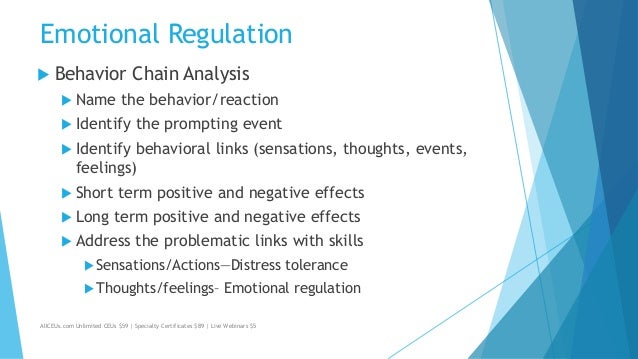A task analysis is an intervention which links a series of behaviors to create a more complex behavior chain. Constructing the intervention chain must be done BEFORE the intervention begins. One should also use the client’s repertoire for selecting appropriate interventions. An evaluation of the client’s verbal repertoire and pre-attending skills are done before the. Both CBT (cognitive behavioral therapy) and DBT (dialectical behavioral therapy) use the powerful tool of behavior chain analysis to examine how a person's thoughts lead to harmful or resilient behaviors when a person is facing a challenging situation.
- Chain Analysis Formdialectical Behavioral Training Techniques
- Training Courses Dialectical Behavior Therapy
- Dialectical Behavioral Therapy Definition
Natalie Hill has a great blog post about behavior chain analysis in DBT.

Here is a link to Practice Wisdom: http://practicewisdom.blogspot.com/2012/10/behavior-chain-analysis.html
Chain Analysis Formdialectical Behavioral Training Techniques
One of the cool images is a visual chain analysis.I will approach the behavior chain analysis from a checklist perspective, as found in Marsha Linehan's Cognitive-Behavioral Treatment of Borderline Personality Disorder (The Big Red Book; 1993; p. 256).
 Step One: The therapist helps the client DEFINE THE PROBLEM BEHAVIOR.
Step One: The therapist helps the client DEFINE THE PROBLEM BEHAVIOR. - The therapist helps the client formulate the problem in terms of behavior.
- The therapist helps the client describe the problem behavior specifically, in these terms: FREQUENCY of behavior, DURATION of behavior, INTENSITY of behavior, and TOPOGRAPHY of behavior.
- The therapist weaves validation throughout.
Note: These topics can be very dysregulating for the client, potentially bringing out shame, angry, sadness, guilt, despair, hopelessness, and even suicidality. Be sure to avoid shaming the client or instituting a punishment. Why? Punishment is not effective in the long-term; as DBT therapists, our goal is to use reinforcement to shape behavior. She likely feels enough guilt or shame already, so there is no need to add more. In looking at guilt and shame, there is a key distinction: shame is feeling bad about who you are, while guilt is feeling bad about something you did.
Step Two: The therapist conducts a CHAIN ANALYSIS
- The therapist and client choose one instance of a problem to analyze.
- The therapist attends to small units of behavior (the links of the chain), with attention to defining the chain's beginning (antecedents), middle (the problem instance itself), and the end (consequences) in terms of the following: EMOTIONS, BODILY SENSATIONS, THOUGHTS and IMAGES, OVERT BEHAVIORS, and ENVIRONMENTAL FACTORS.
- The therapist conducts brief chain analyses as necessary of events in the session.

- The therapist maintains client's (and own) cooperation.
- The therapist helps the client develop methods to monitor her behavior between sessions.
Training Courses Dialectical Behavior Therapy
Step Three: The therapist GENERATES HYPOTHESES with the client about variables influencing or controlling the behaviors in question.
- The therapist uses the results of previous analyses to guide the current one.
Dialectical Behavioral Therapy Definition
- The therapist is guided by DBT theory.Now that we have an outlined list of what to do, let's explore what not to do.
Avoid avoiding behavior chain analyses. I know they're tedious and can be triggering for the therapist and the client. But think of the rich data that comes in knowing what happened and the potential for finding patterns that can isolate the environmental factors that influenced the target behavior.
As a therapist, avoid insisting that your hypothesis is the right hypothesis. A) Forcing your conclusion on the client can invalidate her perspective, as this perpetuates the cycle of invalidation. B) This is not dialectical. The dialectical perspective would find a way to take the 'truth' of each perspective and integrate them.
 As a therapist, avoid putting on the blinders in the case conceptualization and treatment. As in horse racing, when the therapist has a limited view of what she views as the problem behavior, she runs straight down the path and misses information on either side. Searching for the observations/data that match your hypotheses is biased and not scientific.
As a therapist, avoid putting on the blinders in the case conceptualization and treatment. As in horse racing, when the therapist has a limited view of what she views as the problem behavior, she runs straight down the path and misses information on either side. Searching for the observations/data that match your hypotheses is biased and not scientific.